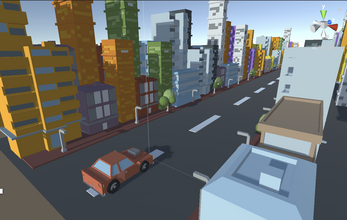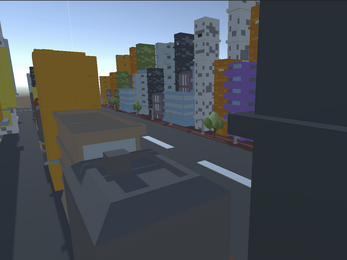Pallae: The STT Game
Replay the game to ask all the questions there are 7 in total.
Spacebar: Slows the vehicle
F5: to pause the game "reload the page"
Left Click: to select questions
Algae is a special and adaptable organism that can be used for a range of environmental advantages, including the cleansing of air and water. Through photosynthesis, which transforms carbon dioxide and other toxic compounds into oxygen and biomass, algae are capable of absorbing contaminants.
Algae can be used as a pollution-eating cladding material for building exterior walls and roofs. Carbon dioxide, nitrogen oxides, and other air pollutants are continuously absorbed by the coating, which functions as a "living filter." In metropolitan areas where air pollution is a big issue, this helps to lower the levels of these dangerous compounds in the environment and improve air quality.
Algae cladding has the ability to reduce pollutants while also assisting in temperature and humidity control within structures. This is due to the algae's ability to remove moisture through transpiration, which contributes to the preservation of a cozy indoor climate. Additionally, algae cladding can act as insulation, lowering the amount of energy needed for heating and cooling.
Algae cladding is an eye-catching and distinctive design element that can be added to buildings. The cladding can be made in a number of forms, sizes, and hues, and as the algae develop, so can its appearance.
Overall, using algae as a cladding material is a step toward developing structures that are more environmentally responsible and sustainable. Buildings can be made into dynamic, self-sustaining ecosystems that actively promote the health and well-being of the environment and its occupants by utilizing the natural skills of algae.
To learn more about the different types of Algae Claddings:
Password: STT
https://badger-ray-bgdr.squarespace.com/home
Audio's Script:
PALLAE
Welcome to Pallae,
the video game that gives you the power to change the world. You can play this game to learn about cutting-edge technologies, and environmentally friendly materials, and how to use them to build structures that are green and absorb pollution.
As you use algae as a pollution-eating cladding material to convert buildings into eco-friendly structures, you will become an advocate for a greener future. You will learn how to employ algae in Pallae in a way that not only lessens pollution but also enhances a building's attractiveness. You will discover the advantages of employing algae as a cladding material, including how it can lower carbon emissions and enhance air quality.
You will learn from the game.
*1---What is the purpose of using algae as a cladding material?
*By absorbing pollutants from the air and water and dissolving them into safe molecules algae serves as a cladding *material with the goal of reducing pollution. This not only contributes to environmental cleanup but also gives *nearby species a source of food and oxygen.
*2---How long does Algae Cladding last?
*Algae cladding's lifespan can vary significantly based on a number of variables, including the environment, the *weather, and the kind of algae being employed. Algae cladding, however, is thought to be durable for several *decades with the right upkeep. This is based on research and actual experiences installing algae cladding. It's *crucial to remember that the durability of algae cladding can be affected by a wide range of variables and may *change from case to instance.
*3---How does Algae Cladding compare in cost to traditional cladding materials?
*Algae cladding can cost more or less than conventional cladding materials, depending on the building's size the *type of cladding utilized and the location. It costs more than conventional cladding materials like brick, stone, *or concrete in general algae Cladding can cost many times more per square meter than conventional materials, *which is a sizable price difference. It is significant to note that the long-term environmental and financial *advantages that algae cladding offers, such as decreased pollution and energy savings, may outweigh the initial *cost difference between algae cladding and conventional cladding materials. Algae Cladding is also a long-term, *cost-effective alternative because it needs little maintenance and has a long lifespan. Meaning the precise cost *comparison between algae cladding and conventional cladding materials depends on a variety of variables and *varies from situation to situation.
*4---How does Algae Cladding contribute to reducing carbon footprint?
*Algae cladding can minimize a building's carbon footprint since it uses photosynthesis to take up carbon dioxide *CO2 from the atmosphere, the amount of CO2 in the atmosphere which is a significant cause of climate change is *reduced as a result of this process. According to studies, algae cladding can significantly lower a building's *carbon footprint by absorbing massive amounts of CO2. Algae Cladding is a sustainable building material that *further minimizes its carbon footprint because neither its production nor installation require the use of fossil *fuels. The overall effect of algae cladding on a building's carbon footprint will vary depending on the size of *the structure, the surrounding climate and the kind of algae cladding employed.
*5---Does Algae Cladding require special tools or equipment for installation?
*Algae Cladding is often installed without the use of specialized tools or equipment. Growing the algae on a *substrate like a mesh or a panel and adhering the substrate to the building using adhesive or other fastening *techniques are the basic steps in the installation of algae cladding. In some circumstances, extra tools can be *needed to give the algae enough light, water, and nutrients. However this technology is frequently *straightforward and easily accessible, and using it does not call for specific knowledge or skills. Overall, *installing algae cladding is a simple process that requires little additional equipment or resources and can be *finished by most building contractors.
*6---What are the different types of Algae Cladding?
*There are several different types of Algae Cladding, including:
*-Microalgae Cladding:
*-Macroalgae Cladding:
*-Algal Biofilm Cladding:
*-Hybrid Algae Cladding:
*Each type of Algae Cladding has its own unique advantages and disadvantages, and the best choice will depend on *the specific needs and goals of the building and its environment to know more on each type of cladding please *scroll down once finished with the game.
*7---What type of pollutants can Algae Cladding remove?
*These are categorized in two types first being air
*1--Algae Cladding can remove a wide range of air pollutants including:
*-Carbon Dioxide (CO2) Which are harmful air pollutants
*-Nitrogen Oxides (NOx) Which are harmful air pollutants
*-Sulfur Oxides (SOx) which are harmful air pollutants
*-Volatile Organic Compounds (VOCs) Which are harmful air pollutants
*secound being water
*2--Algae Cladding can remove a wide range of water pollutants including:
*-Heavy Metals Which are harmful water pollutants such as lead and mercury
*-Organic Waste Which are harmful water pollutants such as sewage and food waste
*-Pesticides and Herbicides Which are harmful water pollutants
*Overall, Algae Cladding is an effective solution for removing a wide range of pollutants from the air and water, making it a promising technology for improving environmental health.
| Status | Released |
| Platforms | HTML5 |
| Author | Pallae |
| Genre | Educational |
| Tags | 3D, Driving, Indie, Relaxing, Short, Singleplayer |
| Average session | A few minutes |
| Languages | English |
| Inputs | Keyboard, Mouse |


